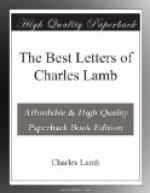With the tragical events just narrated, the storm of calamity seemed to have spent its force, and there were thenceforth plenty of days of calm and of sunshine for Charles Lamb. The stress of poverty was lightened and finally removed by successive increases of salary at the India House; the introductions of Coleridge and his own growing repute in the world of letters gathered about him a circle of friends—Southey, Wordsworth, Hazlitt, Manning, Barton, and the rest—more congenial, and certainly more profitable, than the vagrant intimados, “to the world’s eye a ragged regiment,” who had wasted his substance and his leisure in the early Temple days.
Lamb’s earliest avowed appearance as an author was in Coleridge’s first volume of poems, published by Cottle, of Bristol, in 1796. “The effusions signed C.L.,” says Coleridge in the preface, “were written by Mr. Charles Lamb, of the India House. Independently of the signature, their superior merit would have sufficiently distinguished them.” The “effusions” were four sonnets, two of them—the most noteworthy— touching upon the one love-romance of Lamb’s life, [9]—his early attachment to the “fair-haired” Hertfordshire girl, the “Anna” of the Sonnets, the “Alice W—–n” of the Essays. We remember that Ella in describing the gallery of old family portraits, in the essay, “Blakesmoor in H—–shire,” dwells upon “that beauty with the cool, blue, pastoral drapery, and a lamb, that hung next the great bay window, with the bright yellow Hertfordshire hair, so like my Alice.”
In 1797 Cottle issued a second edition of Coleridge’s poems, this time with eleven additional pieces by Lamb,—making fifteen of his in all,—and containing verses by their friend Charles Lloyd. “It is unlikely,” observes Canon Ainger, “that this little venture brought any profit to its authors, or that a subsequent volume of blank verse by Lamb and Lloyd in the following year proved more remunerative.” In 1798 Lamb, anxious for his sister’s sake to add to his slender income, composed his “miniature romance,” as Talfourd calls it, “Rosamund Gray;” and this little volume, which has not yet lost its charm, proved a moderate success. Shelley, writing from Italy to Leigh Hunt in 1819, said of it: “What a lovely thing is his ‘Rosamund Gray’! How much knowledge of the sweetest and deepest part of our nature in it! When I think of such a mind as Lamb’s, when I see how unnoticed remain things of such exquisite and complete perfection, what should I hope for myself if I had not higher objects in view than fame?”
It is rather unpleasant, in view of this generous—if overstrained— tribute, to find the object of it referring later to the works of his encomiast as “thin sown with profit or delight.” [10]
In 1802 Lamb published in a small duodecimo his blank-verse tragedy, “John Woodvil,”—it had previously been declined by John Kemble as unsuited to the stage,—and in 1806 was produced at the Drury Lane Theatre his farce “Mr. H.,” the summary failure of which is chronicled with much humor in the Letters. [11]




